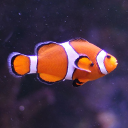The clown anemonefish (Amphiprion ocellaris), also known as the false percula clownfish or common clownfish, is a marine fish belonging to the family Pomacentridae, which includes clownfishes and damselfishes. A. ocellaris is the most basal species in the genus Amphiprion which is closely related to the genus Premnas. The species' most closely related ancestor is Amphiprion percula, the Orange clownfish. It is thought that A. ocellaris specialized after diverging from the genus Premnas, and scientific evidence confirms that all clownfish belonging to the genus Amphiprion initially could withstand the stings of only one type of anemone; after further speciation the 28 different species of clownfish including A. ocellaris have specialized to be able to resist the poisonous stings of many different anemone species.
Assembly
The ASM2253959v1 assembly was submitted by Okinawa Institute of Science and Technology on March 2022. The assembly is on chromosome level, consisting of 1,808 contigs assembled into 354 scaffolds. From these sequences, 24 chromosomes have been built. The N50 size is the length such that 50% of the assembled genome lies in blocks of the N50 size or longer. The N50 length for the contigs is 812,338 while the scaffold N50 is 36,880,113.
Other assemblies
- AmpOce1.0 (Ensembl release 111)
Gene annotation
The gene annotation process was carried out using a combination of protein-to-genome alignments, annotation mapping from a suitable reference species and RNA-seq alignments (where RNA-seq data with appropriate meta data were publicly available). For each candidate gene region, a selection process was applied to choose the most appropriate set of transcripts based on evolutionary distance, experimental evidence for the source data and quality of the alignments.Small ncRNAs were obtained using a combination of BLAST and Infernal/RNAfold. Pseudogenes were calculated by looking at genes with a large percentage of non-biological introns (introns of <10bp), where the gene was covered in repeats, or where the gene was single exon and evidence of a functional multi-exon paralog was found elsewhere in the genome. lincRNAs were generated via RNA-seq data where no evidence of protein homology or protein domains could be found in the transcript.
In accordance with the Fort Lauderdale Agreement, please check the publication status of the genome/assembly before publishing any genome-wide analyses using these data.
More information
General information about this species can be found in Wikipedia.
Statistics
Summary
| Assembly | ASM2253959v1, INSDC Assembly GCA_022539595.1, Mar 2022 |
| Base Pairs | 863,484,803 |
| Golden Path Length | 863,484,803 |
| Annotation provider | Ensembl |
| Annotation method | Full genebuild |
| Genebuild started | Dec 2022 |
| Genebuild released | |
| Genebuild last updated/patched | Dec 2022 |
| Database version | 115.1 |
Gene counts
| Coding genes | 22,859 |
| Non coding genes | 3,468 |
| Small non coding genes | 617 |
| Long non coding genes | 2,844 |
| Misc non coding genes | 7 |
| Pseudogenes | 143 |
| Gene transcripts | 76,033 |
